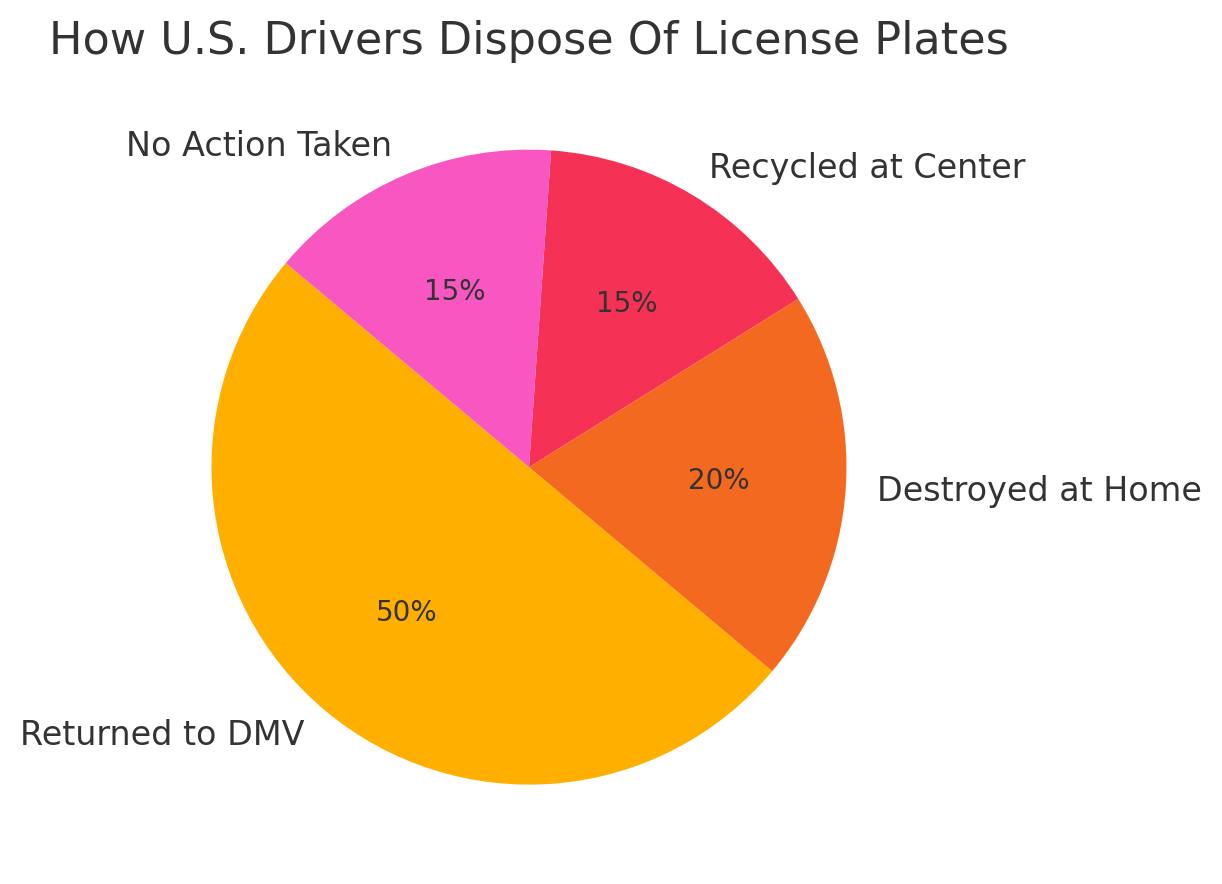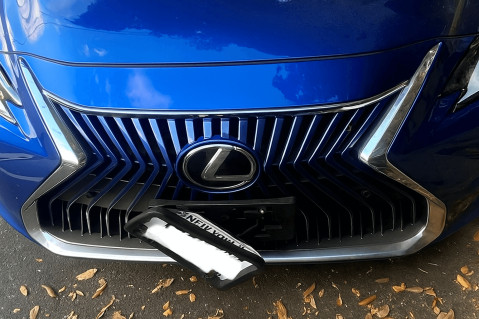The safest way to get rid of old license plates is to destroy them, return them to the DMV, or recycle them at a metal center. Some states have special requirements, especially if the plate still has stickers or a valid registration. Throwing plates in the trash can lead to fines or identity theft. The proper disposal of old license plates protects you from legal issues and keeps others from misusing your number. Below, we provide specific instructions and explain how to meet your state’s rules or turn the plates into new items without breaking the law.
Why You Shouldn’t Just Throw Away Old License Plates
EpicVIN data shows that over 18% of theft-recovered cars had their original vehicle plates reused in fraudulent activities. Tossing old plates in the trash may seem harmless. However, it opens the door for someone to take them. Such a plate may be attached to a stolen or unregistered car. If a person drives off with your old number, you could be linked to accidents, tickets, or crimes. That’s a serious risk not worth taking.
Criminals often target trash bins and junkyards. They look for certain types of plates, especially ones with valid tags or from popular models. Once they get them, they create cloned cars or bypass toll systems using your identity. Get a new set of plates later? Anyway, your old number could still show up in traffic violations or unpaid tolls. Remember that destroying the plates properly protects your name.
Comparison: Destroy, Recycle, Surrender, or Upcycle?
About 61 percent of Americans choose to recycle or destroy old license plates, but many still don’t know which option gives full protection or saves the most effort.
| Method | Used by (%) | Privacy Protection | Eco Impact | Effort Level | Extra Info |
| Destroy | 22 | High | Low | Low | This method is complete and safe, but the metal is wasted. |
| Recycle | 39 | Medium | High | Medium | You can recycle license plates at a local recycling center. Curbside recycling is not accepted. |
| Surrender | 28 | High | Medium | Medium | DMV collects and removes old license plates through official programs. |
| Upcycle | 11 | Low | Medium | High | Some artists turn plates into signs or frames. Manufacturers simply melt similar materials. |
Methods to Destroy Old License Plates at Home

There are several acceptable ways to handle old plates without leaving home. The goal is to make them unusable while staying safe. These methods work well for modern aluminum license plates. They’re often date-stamped and easy to break down with basic tools.
Bend or Fold the Plate
Bending a plate makes it useless for resale or illegal use. You can:
- Wear gloves to safeguard your hands.
- Fold the plate inward until it creases or snaps.
- Step on it with firm pressure/use a vice.
- Repeat in the opposite direction to create multiple folds.
Scratch or Mark Out the Numbers

Many car enthusiasts wonder: How to destroy old license plates without cutting them? Scraping off the numbers removes any identifying value. Instead, utilize a metal file, sandpaper, or a screwdriver. They can help dig into the surface. Focus on the embossed areas and any year decals (they may still be valid). Some plates with certain colors or reflective film can be harder to mark, so apply enough force to damage the surface completely. As an example, many vanity plates have thicker coatings and may take longer to deface. Once the characters are no longer visible, the plate loses its ability to be misused.
Cut the Plate Into Pieces
This option works best if you're wondering how to cut license plates safely.
- Place the plate on a sturdy surface, e.g., a workbench.
- Use tin snips/metal-cutting shear for clean slices.
- Cut across the numbers first and then into quarters.
- Wear safety glasses to prevent eye injury.
- Dispose of each piece separately to prevent reassembly.
- Never attempt this near fuel, batteries, or structural damage to a car.
Further reading
Are Vanity Plates Exempt From Destruction Rules?
According to the American Association of Motor Vehicle Administrators, around 9.7 million vanity plates are registered in the United States. Despite their custom design, unused license plates with steel bases or visible year tabs remain traceable to a specific person. That makes them a target for fraud or toll evasion. These plates should be destroyed, recycled, or surrendered just like any standard tag.
State Laws and DMV Requirements for Plate Disposal
Every state treats plate disposal differently and links it to your vehicle’s title and registration process at the state’s vehicle licensing department. In some areas, you must return license plates when you sell or transfer a car. In Washington state and several others, you bring your plates in person to the vehicle licensing office. That step updates the record and ensures you are not responsible for tolls or violations tied to those plates. It also clears your name officially with DMV.

According to EpicVIN's research, fifty percent of vehicle owners return license plates to the DMV. Twenty percent destroy them at home. Fifteen percent drop in plates at recycling centers. The remaining fifteen percent do nothing and leave the plates unused. Those who return license plates tend to avoid future legal issues and unwanted charges linked to old plates.
Can You Recycle License Plates With Stickers Still On?
Aluminum license plates can usually be recycled, but most metal recycling centers ask that you remove any stickers first. If you cannot peel them off, write over the numbers with a marker and place the plate in an aluminum recycling bin if accepted.
Here are practical things to do with old license plates before recycling:
- Scratch out all readable numbers on newer plates.
- Use pliers to bend the plate and reduce reuse risk.
- Write across the front with a permanent marker.
- Try soaking the plate in hot water to loosen stickers.
- Avoid burning stickers to limit carbon emissions.
- Contact your local facility to confirm sticker policies.
- Do not toss plates with tags into curbside bins without checking first.
Can You Reuse or Sell Old Plates Legally?
Repurposing license plates for art or resale may seem harmless. Nevertheless, many states have strict limits. In the first state to issue plates, Delaware, some rare tags are collectible. However, a receipt showing the transfer is often required. If the registration is still active, reuse can link you to unpaid tolls or violations. To be safe, visit a tax collector's office or motor vehicle service center. Verify whether your old plate can be transferred or must be surrendered. Some locations accept license plates for official disposal only if they come from a canceled record. Before selling, always run a license plate lookup or check the VIN decoder history to confirm that the plate is no longer in use.
What Happens If Someone Reuses Your Old Plate Illegally
If someone illegally reuses your old plate, it can result in toll charges, traffic tickets, or even criminal records tied to your vehicle registration, and recovering from it can cost serious time and money.
| Incident Type | % of Plate Misuse Cases | How It Happens | How to Prevent It |
| Toll Evasion | 42 | The stolen plate was used to avoid payment | Drop off old license plates at a state licensing office |
| Traffic Violations | 27 | Fake tags are used to add decals to similar cars | Deface or destroy tags before disposal |
| Vehicle Cloning | 18 | Matching plate and VIN copied | Keep your mailing address off public listings in the vehicle history report |
| Fraudulent Vehicle Sales | 8 | Reused tags linked to fake listings | Never give away plates after canceling vehicle registration |
| Legal Penalties | 5 | The owner is held liable unless proof of disposal is shown | Keep a receipt if you surrender plates by mail or in person |
Summary
Choose from several alternatives if you’re planning to get rid of old plates. Take your state rules and personal needs into account. You can destroy the plate, recycle it, or return it to the DMV. Alternatively, donate it for creative reuse. Contact your local Department of Motor Vehicles if you are unsure about any step. Always deface or disable the plate. Correct disposal protects your name and money.
Frequently Asked Questions
Spray the screw heads. Apply rust-penetrating oil like WD-40 and wait 10-15 minutes. Use a screwdriver with steady pressure and/or try light tapping to break the rust loose.
Generally, no. When registering your vehicle in a new state, you'll need to turn in your previous license plates.
No. Regular recycling programs typically won't take them. Plates have sharp edges and a reflective coating. Consider bringing them to a certified metal recycling facility.
Definitely don't do that. Metal plates will spark and cause fires in microwaves. Instead, try using a heat gun or hair dryer. Then, carefully peel the sticker off by hand.
Yes. Even if only one plate was displayed on the vehicle, both plates are linked to your registration to prevent misuse, defacing, or destruction of both plates before disposal.







